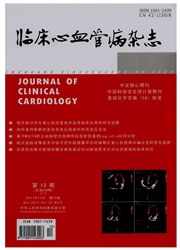

 中文摘要:
中文摘要:
目的:探讨静脉使用地尔硫治疗非ST段抬高型急性冠状动脉综合征(ACS)难治性心肌缺血的临床疗效。方法:选自我院心血管重症病房收录在常规治疗基础上联合静脉使用地尔硫治疗的非ST段抬高型ACS难治性心肌缺血患者62例,分析其合并因素、冠脉病变特点及相关临床特征,观察使用地尔硫治疗后其心绞痛控制情况及不良反应发生比例。结果:难治性心肌缺血组糖尿病及慢性肾病合并比例、冠脉闭塞病变、弥漫多支病变及左主干病变高于对照组,是难治性心肌缺血患者的重要临床特征。使用静脉地尔硫治疗后90.3%的患者心绞痛可以满意控制,同时,总体不良反应率很低。结论:静脉注射地尔硫对一时难以进行血运重建的患者是一种高效且相对安全的控制心肌缺血的治疗措施,值得在临床积极使用和进一步积累经验。
 英文摘要:
英文摘要:
Objective:To investigate the clinical effect of intravenous diltiazem on refractory myocardial ischemia in patients with non-ST elevation acute coronary syndrome.Method:We collected 62 patients with refractory myocardial ischemia in patients with non-ST elevation acute coronary syndrome from the cardiovascular intensive care unit in our hospital who received conventional treatment or joint use of intravenous diltiazem treatment.We analyzed the clinical and coronary lesion characteristics in the refractory myocardial ischemia group and evaluated the effect on the angina control rate and adverse reactions ratio.Result:The proportion of diabetes and chronic renal disease and some type of coronary lesion,such as chronic total occlusion,diffuse multi-vessel disease and left main lesion were common in refractory myocardial ischemia group,which were important clinical features of patients with refractory myocardial ischemia.There were 90.3% of patients with refractory myocardial ischemia could be controlled using intravenous diltiazem combined with conventional treatment,while the rate of adverse effects was very low.Conclusion:Intravenous diltiazem is an efficient and relatively safe treatment in the control of myocardial ischemia in patients with refractory myocardial ischemia who were difficult to perform revascularization procedure.Intravenous diltiazem may play agreat role in the control of refractory myocardial ischemia.
 同期刊论文项目
同期刊论文项目
 同项目期刊论文
同项目期刊论文
 期刊信息
期刊信息
